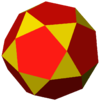With a cuboctahedron, you have 8 triangular faces and 6 square faces. If you took 8 coils and supported them so they were on the faces of an octahedron in the same fashion that the WB-6 has six coils on the faces of a cube, then you would have 8 physical solenoids and 6 virtual solenoids and the overall geometry would be identical to that of the WB-6, just with more coils.TallDave wrote:Yes, that's interesting. I saw it suggested in there somewhere that you could also (in theory) wire the virtual solenoids instead.The other type, the "virtual" solenoids aren't as obvious: Around each of the 8 vertices of the cube, there are three large currents from the three adjacent physical solenoids forming a triangle (a very curvy triangle, but a triangle) with the currents going counterclockwise when viewed from the outside. Since all the physics cares about is a circulating current around the axis of the solenoid, doing it in three unconnected segments is perfectly fine, and you get a solenoid without a coil.
If you made the coils with a polygonal plan-form, you could use 8 triangular coils and 6 square coils and completely eliminate the virtual coils, but there's no need.
KitemanSA posted a picture of a cuboctahedron, but it apparently caused problemsYes, having trouble visualizing that, but it sounds like it makes sense. Is there a picture of this floating around anywhere? Too much to hope I expect.The appearance of the WB-6/7/8/8.1 is cubic, with six coils on the faces of the cube, but the underlying physics is cuboctahedral, with inward pointing (physical) solenoids on the 6 square faces and outward pointing (virtual) solenoids on the 8 triangular faces. The vertices of the cuboctahedron are at the 12 points where the physical coils come close to touching. Around each of these twelve points are 4 solenoids, two pointing in, two pointing out, alternating. This arrangement, of alternating inward and outward solenoids is the key to Bussard's design for the polywell.

The second one (truncated cube) shows roughly the geometry of the WB-6. It's easy to imagine the round coils on the red faces, which would correspond to the physical solenoids, while the yellow faces would correspond to the virtual ones. The edges where two red faces join are the sources of the "line cusps", and are not desirable.

The third one (cuboctahedron) is the "plan geometry" the WB-6 is trying to emulate, and would be what you would get if you followed KitemanSA's long-stated goal to have polygonal coils instead of round ones. With this, you could use either the square or triangular faces as "real", as the polygonal coils would follow the edges, except near the vertices. At the 12 vertices the fields cancel out (because of symmetry) and this forms the "funny cusps" that Bussard talks about. Again, the red faces point in, the yellow faces point out.
Note the key feature Bussard stressed: if you look at a vertex (any one, they are all the same) you'll note that the faces meeting at that vertex are alternately colored red and yellow. Any polyhedron which has that property is suitable for forming a polywell, but the more spherical the better.

The fourth one (truncated octahedron) is what you would get if you used 8 round coils on the faces of an octahedron. In this case, the red faces are virtual solenoids while the yellow faces are physical solenoids. And like in the truncated cube case, the edges where the yellow faces meet cause line cusps and losses.
BTW, The geometry Bussard wanted to use for the original WB-8 was the icosidodecahedron, which looks like this:
